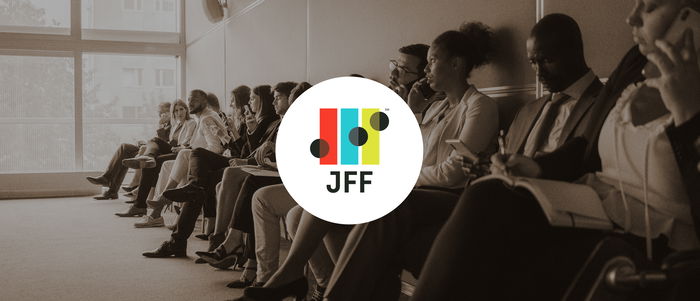
Recovery for the Workforce Requires Innovation by the Workforce System
June 9, 2020
At a Glance
Workforce leaders are designing recovery strategies that are future-focused.
This is a moment of cataclysmic change for the workforce system. Virtually overnight, 2,400 job centers were required to pivot decades of in-person work to online interaction focused on people whose access to technology is often limited.
Today, “recovery” for the workforce system doesn’t mean going back to the ineffective learning and training interventions of the past. It means finding completely new ways of helping workers access job search assistance, training, and crucial support services from the safety of their homes. It means adjusting to new norms and inspiring colleagues and clients to adapt to remote work experiences and distance learning.
It means fixing broken, inequitable systems that will require all of us to challenge unjust policies and procedures.
These systems don’t exist outside of racist actions that further reinforce that we do not live in a just, equitable world. We agree with and are inspired by Clair Minson, assistant vice president, New Orleans Business Alliance, in recognizing that the workforce development system is meant to provide access points for people to discover opportunity and explore their purpose. And yet we know that our workforce systems perpetuate systemic inequities, especially for people of color. They have upheld the myth of meritocracy, while prioritizing employer demand over worker needs and created criteria that serve as hurdles that disproportionately limit opportunities for black and brown job seekers.
Acknowledging this truth is a first step. An important second is taking real impactful action. It can start with highlighting the efforts of workforce boards and job centers that embrace responsive, comprehensive, and effective strategies for supporting workers and learners as they confront a new reality and navigate complex challenges.
Our work to-date has only implicitly recognized the equity imperative. We can’t set out to transform the workforce system or help get 42 million people back to work without confronting equity explicitly. Doing so will take more discussion and require us to examine this framework for action through a new lens that puts equity and racial justice in the foreground. It’s not one of many issues to be recognized and solved for in the workforce system, instead, it is the primary issue that we must center our work on if we want to truly be ‘future-focused’ and if we’re actually serious about the workforce system playing a primary role in an equitable economic recovery.
Across the country, equity and future-focused workforce organizations are adapting their operations, strategies, technologies, and investments to a changing world through strategic partnerships committed to making an impact in their communities. Others are finding that systemic, structural, and regulatory challenges limit their ability to adapt. If these challenges are resolved, these groups could provide greater economic stability for people and improved talent pipelines for businesses.
We found that some of the country’s most future-focused workforce organizations share four defining characteristics and engage in behaviors such as these:
- Seek out strategic opportunities to expand their influence
- Collect and analyze vast amounts of data
- Adopt human-centered policies and procedures
- Embrace new technologies
These organizations are poised to lead the recovery, and the workforce professionals who power them are examples of transformational leadership in this singular moment. Representatives of three organizations will be joining JFFLabs in a session at Horizons, JFF’s flagship national event. Here’s a look at some of the ways they are driving change.
- The Spokane Workforce Council uses technology for a variety of customer-facing supports. For example, it has a platform called TablesReady that it uses to better manage customer intake and communication and assess wait times. Council employees also engage in human-centered design thinking across all activities, including the functional, physical, and philosophical redesign of the organization’s American Job Center, WorkSource Spokane.
- CareerSource Central Florida (CSCF) is committed to using best-in-class technology tools and upgrading current systems. The organization has developed a hybrid private and public cloud environment that uses Citrix virtualization software to provide users with full desktop access via Microsoft 365 applications. Network security upgrades introduced live event log management functionality, network monitoring tools, phishing protection software, and offsite replication capabilities to support business continuity. To meet the needs of customers limited to online interactions during the pandemic, CSCF has created virtual workshops and job fairs and developed a digital contact center and appointment tool. Moreover, the organization’s business intelligence department has expanded its use of data analysis tools to, among other things, more efficiently track jobseekers based on various attributes.
- The San Diego Workforce Partnership combines flexible funding streams and technologies to offer online customer service and learning opportunities to all job center clients. It utilizes innovative funding models (such as income-share agreements) to help clients cover the cost of training for quality credentials. It has also developed a methodology for assessing job quality—an initiative funded through targeted investments. In addition, the organization offers a number of free and paid services, including labor market research, career coaching for K-12 teachers, and informational sessions to promote inclusive hiring practices and support businesses throughout the recovery.
Before the upheaval spurred by COVID-19, those of us focused on training might have said that preparing Americans for the future of work is the defining domestic issue of our time. And yet, while that still rings true, it’s clear that the window of preparation for the “future of work” has closed, replaced by a pressing need to act in order to recover stronger.
Related Content

AWAKE
Workforce boards support 15 million Americans each year. JFF provides insights and advice to workforce leaders as they navigate change. The future of work is now, and many workforce boards are aggressively pursuing greater efficiency,…

How Workforce Boards Show the Way Toward the Future of Work
Future-focused workforce leaders excel in today’s rapidly changing world. About Future-Focused Workforce Boards In addition to clarifying the challenges and opportunities facing the workforce development system, AWAKE’s interviews with workforce board leaders revealed a clear…
